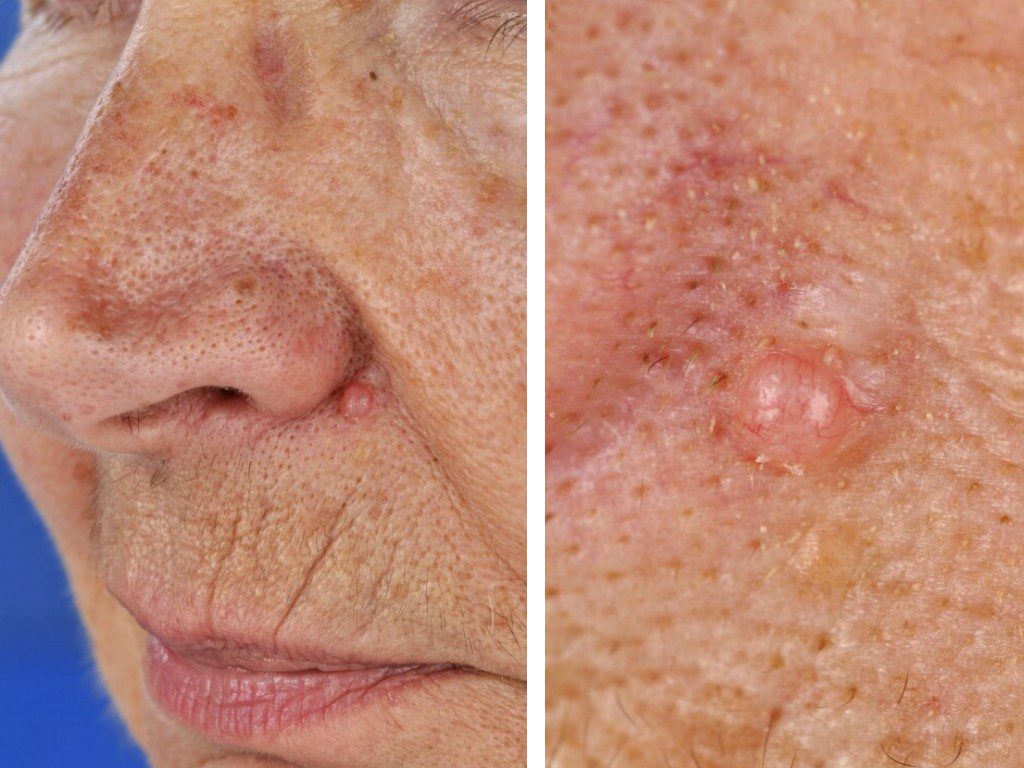Skin cancer
Skin cancer is the most common in the Netherlands compared to other forms of cancer. There are different forms of skin cancer. Basal cell carcinoma (BCC) is the most commonly seen, followed by squamous cell carcinoma and melanoma.
During life, about 1 in six Dutch people develop one or more BCC. It arises in the top layer of the skin. The main cause is sun exposure. This concerns both accumulated sun exposure during life, but also sun burns, especially in the youth. This results in irreparable damage to the skin, which can cause skin cancer to develop. In the vast majority of cases, the skin cancer can be treated well with skin cancer surgery. Mohs surgery is used for complex basal cell carcinoma on the face.
Basal cell carcinoma on the face
Basal cell carcinoma on the face can present itself in different ways. It can be a somewhat shiny bump that slowly grows in size, such as in “nodular” basal cell carcinoma. It can also be flatter and the distinction from normal skin is sometimes difficult to make, such as with the “infiltrating” basal cell carcinoma. A basal cell carcinoma often does not cause any complaints, but it can manifest itself as a wound on the skin that does not heal or a spot that always bleeds easily when touched. With these characteristics, it is important to see your doctor or a dermatologist if you are already known there.
Skin cancer surgery
Basal cell carcinoma on the face is usually excised. Gone is gone. There is a small chance that the skin cancer can come back. Simple basal cell carcinomas can be removed with normal surgery, that is, the area is cut out with a margin of healthy skin under local anesthesia and the wound closed immediately. The excised tissue is sent for pathological examination and you will usually receive the results after 2 weeks.
Mohs surgery is used for troublesome basal cell carcinoma on the face. This concerns basal cell carcinoma in the face that is in an unpleasant place where you do not want to remove too much healthy tissue as a margin or that cannot simply be closed but with a skin graft or so-called skin plastic, Mohs surgery may only be applied when a number of full values are met. This mainly concerns basal cell carcinomas on the nose and around the eyes and ears (called H zone). In addition, it is the somewhat larger basal cell carcinomas, often with a more aggressive growth habit in the face, that are treated with Mohs surgery. Relapses (a basal cell carcinoma that has already been removed before but has come back in the same place) and basal cell carcinomas that have not been completely removed with previous treatment.
Mohs chirurgie in the Roosevelt kliniek
In Mohs surgery, the visible skin cancer is cut out with a small margin under local anesthesia in a special way. The wound is not closed yet, but is temporarily bandaged. The patient takes a seat in the waiting room. The cut tissue is processed and can then be assessed. If the cut edges are not free, extra tissue is cut away where there is still some. This happens until everything has been removed. Then the wound is closed. More information on how the Mohs treatment works and find a patient leaflet on this page.
The medical specialists at the Roosevelt clinic who perform Mohs surgery are specialized in skin cancer and skin cancer surgery. They also work partly in the skin cancer center of the LUMC. In the Roosevelt kliniek, you get best treatment, without requiring you to go to the hospital for this.
